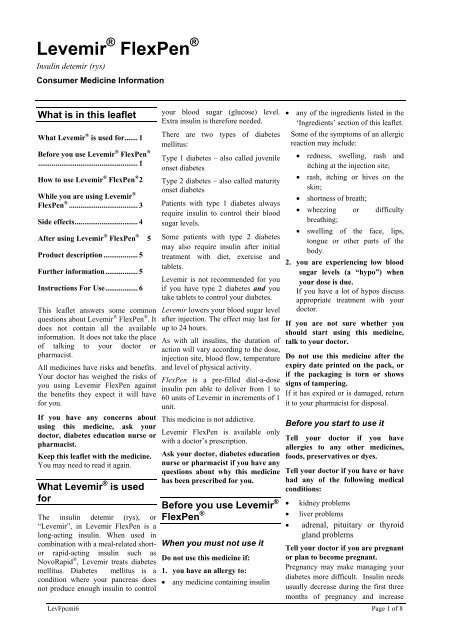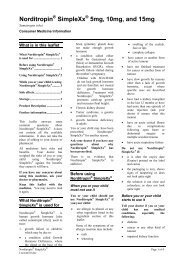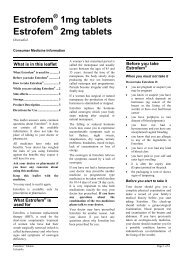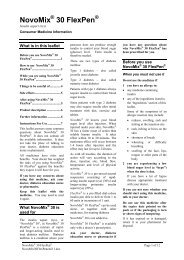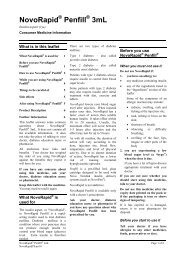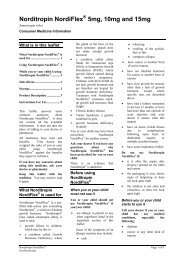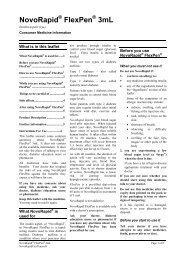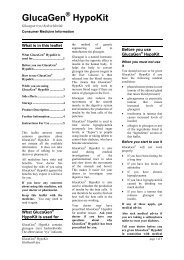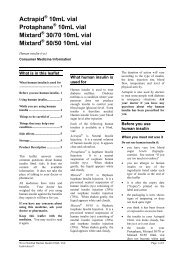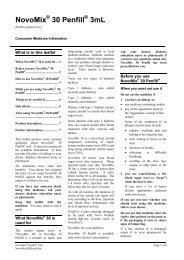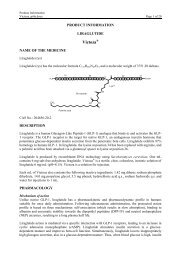Levemir FlexPen - Novo Nordisk Australasia
Levemir FlexPen - Novo Nordisk Australasia
Levemir FlexPen - Novo Nordisk Australasia
Create successful ePaper yourself
Turn your PDF publications into a flip-book with our unique Google optimized e-Paper software.
<strong>Levemir</strong> ® <strong>FlexPen</strong> ®<br />
Insulin detemir (rys)<br />
Consumer Medicine Information<br />
What is in this leaflet<br />
What <strong>Levemir</strong> ® is used for....... 1<br />
Before you use <strong>Levemir</strong> ® <strong>FlexPen</strong> ®<br />
.................................................... 1<br />
How to use <strong>Levemir</strong> ® <strong>FlexPen</strong> ® 2<br />
While you are using <strong>Levemir</strong> ®<br />
<strong>FlexPen</strong> ® .................................... 3<br />
Side effects................................. 4<br />
After using <strong>Levemir</strong> ® <strong>FlexPen</strong> ® 5<br />
Product description .................. 5<br />
Further information................. 5<br />
Instructions For Use................. 6<br />
This leaflet answers some common<br />
questions about <strong>Levemir</strong> ® <strong>FlexPen</strong> ® . It<br />
does not contain all the available<br />
information. It does not take the place<br />
of talking to your doctor or<br />
pharmacist.<br />
All medicines have risks and benefits.<br />
Your doctor has weighed the risks of<br />
you using <strong>Levemir</strong> <strong>FlexPen</strong> against<br />
the benefits they expect it will have<br />
for you.<br />
If you have any concerns about<br />
using this medicine, ask your<br />
doctor, diabetes education nurse or<br />
pharmacist.<br />
Keep this leaflet with the medicine.<br />
You may need to read it again.<br />
What <strong>Levemir</strong> ® is used<br />
for<br />
The insulin detemir (rys), or<br />
“<strong>Levemir</strong>”, in <strong>Levemir</strong> <strong>FlexPen</strong> is a<br />
long-acting insulin. When used in<br />
combination with a meal-related shortor<br />
rapid-acting insulin such as<br />
<strong>Novo</strong>Rapid ® , <strong>Levemir</strong> treats diabetes<br />
mellitus. Diabetes mellitus is a<br />
condition where your pancreas does<br />
not produce enough insulin to control<br />
your blood sugar (glucose) level.<br />
Extra insulin is therefore needed.<br />
There are two types of diabetes<br />
mellitus:<br />
Type 1 diabetes – also called juvenile<br />
onset diabetes<br />
Type 2 diabetes – also called maturity<br />
onset diabetes<br />
Patients with type 1 diabetes always<br />
require insulin to control their blood<br />
sugar levels.<br />
Some patients with type 2 diabetes<br />
may also require insulin after initial<br />
treatment with diet, exercise and<br />
tablets.<br />
<strong>Levemir</strong> is not recommended for you<br />
if you have type 2 diabetes and you<br />
take tablets to control your diabetes.<br />
<strong>Levemir</strong> lowers your blood sugar level<br />
after injection. The effect may last for<br />
up to 24 hours.<br />
As with all insulins, the duration of<br />
action will vary according to the dose,<br />
injection site, blood flow, temperature<br />
and level of physical activity.<br />
<strong>FlexPen</strong> is a pre-filled dial-a-dose<br />
insulin pen able to deliver from 1 to<br />
60 units of <strong>Levemir</strong> in increments of 1<br />
unit.<br />
This medicine is not addictive.<br />
<strong>Levemir</strong> <strong>FlexPen</strong> is available only<br />
with a doctor’s prescription.<br />
Ask your doctor, diabetes education<br />
nurse or pharmacist if you have any<br />
questions about why this medicine<br />
has been prescribed for you.<br />
Before you use <strong>Levemir</strong> ®<br />
<strong>FlexPen</strong> ®<br />
When you must not use it<br />
Do not use this medicine if:<br />
1. you have an allergy to:<br />
• any medicine containing insulin<br />
• any of the ingredients listed in the<br />
‘Ingredients’ section of this leaflet.<br />
Some of the symptoms of an allergic<br />
reaction may include:<br />
• redness, swelling, rash and<br />
itching at the injection site;<br />
• rash, itching or hives on the<br />
skin;<br />
• shortness of breath;<br />
• wheezing or difficulty<br />
breathing;<br />
• swelling of the face, lips,<br />
tongue or other parts of the<br />
body.<br />
2. you are experiencing low blood<br />
sugar levels (a “hypo”) when<br />
your dose is due.<br />
If you have a lot of hypos discuss<br />
appropriate treatment with your<br />
doctor.<br />
If you are not sure whether you<br />
should start using this medicine,<br />
talk to your doctor.<br />
Do not use this medicine after the<br />
expiry date printed on the pack, or<br />
if the packaging is torn or shows<br />
signs of tampering.<br />
If it has expired or is damaged, return<br />
it to your pharmacist for disposal.<br />
Before you start to use it<br />
Tell your doctor if you have<br />
allergies to any other medicines,<br />
foods, preservatives or dyes.<br />
Tell your doctor if you have or have<br />
had any of the following medical<br />
conditions:<br />
• kidney problems<br />
• liver problems<br />
• adrenal, pituitary or thyroid<br />
gland problems<br />
Tell your doctor if you are pregnant<br />
or plan to become pregnant.<br />
Pregnancy may make managing your<br />
diabetes more difficult. Insulin needs<br />
usually decrease during the first three<br />
months of pregnancy and increase<br />
LevFpcmi6 Page 1 of 8
during the last six months. Your<br />
doctor can discuss with you the risks<br />
and benefits involved.<br />
Tell your doctor if you are breastfeeding<br />
or plan to breast-feed.<br />
Your doctor can discuss with you the<br />
risks and benefits involved.<br />
If you have not told your doctor<br />
about any of the above, tell them<br />
before you start using this medicine.<br />
Taking other medicines<br />
Tell your doctor if you are taking<br />
any other medicines, including any<br />
that you get without a prescription<br />
from your pharmacy, supermarket<br />
or health food shop.<br />
Some medicines and <strong>Levemir</strong> may<br />
interfere with each other. These<br />
include:<br />
• oral hypoglycaemic medicines -<br />
used to treat type 2 (non-insulin<br />
dependent) diabetes.<br />
• monoamine oxidase inhibitors<br />
(MAOI) - used for the treatment<br />
of depression<br />
• alpha blockers - used to treat high<br />
blood pressure and to relieve<br />
difficulty in passing urine caused<br />
by an enlarged prostate<br />
• non-selective beta blockers – used<br />
to treat high blood pressure and<br />
certain heart conditions<br />
• ACE inhibitors - used to treat<br />
high blood pressure, certain heart<br />
conditions or elevated<br />
protein/albumin in the urine<br />
• salicylates e.g. aspirin - used to<br />
relieve pain and lower fever<br />
• anabolic steroids – used to<br />
promote growth<br />
• glucocorticoids (except when<br />
applied locally) – used to treat<br />
inflammatory conditions<br />
• oral contraceptives (“the pill”) -<br />
used for birth control<br />
• fluid tablets e.g. thiazides,<br />
frusemide or ethacrynic acid -<br />
used to treat high blood pressure<br />
or fluid retention (oedema)<br />
• thyroid hormones - used to treat<br />
malfunction of the thyroid gland<br />
• sympathomimetics - used to treat<br />
asthma<br />
• sulphonamides – used to treat<br />
bacterial infections<br />
Or other specific medicines including:<br />
• danazol - used to treat<br />
endometriosis, menorrhagia,<br />
fibrocystic breast disease and<br />
hereditary angioedema<br />
• oxymetholone – used to treat<br />
certain blood disorders<br />
Tell your doctor about any other<br />
medicines that you are taking.<br />
This is very important. Your doctor<br />
will advise you if it is alright to keep<br />
taking them or if you should stop<br />
taking them.<br />
Your doctor and pharmacist have<br />
more information on medicines to be<br />
careful with or avoid while using this<br />
medicine.<br />
How to use <strong>Levemir</strong> ®<br />
<strong>FlexPen</strong> ®<br />
Your doctor, diabetes education<br />
nurse or pharmacist will have given<br />
you advice on how to use your<br />
medicine. Carefully follow all the<br />
directions.<br />
They may differ from the information<br />
contained in this leaflet.<br />
Any change in dose or type of<br />
insulin should be made cautiously<br />
and only under medical supervision.<br />
If you change the type of insulin that<br />
you use, you may have to use more or<br />
less than before. This may happen<br />
with the first dose or over a period of<br />
time.<br />
If you do not understand the<br />
instructions, ask your doctor,<br />
diabetes education nurse or<br />
pharmacist for help.<br />
• octreotide - used to treat<br />
gastrointestinal endocrine<br />
tumours<br />
• lanreotide – used to treat How much to use<br />
enlargement of parts of the body<br />
(e.g. hands, feet, head) caused by<br />
abnormal hormone levels<br />
• diazoxide - used to treat high<br />
blood pressure<br />
• nicotinic acid - used to treat high<br />
cholesterol levels in the blood<br />
• asparaginase - used to treat When to use it<br />
leukaemia and lymph gland<br />
tumours<br />
• quinine – used to treat malaria<br />
and relieve muscle cramps<br />
• quinidine – used to treat heart<br />
problems<br />
• growth hormone – used to treat<br />
growth disorders<br />
How to use it<br />
Your doctor or diabetes education<br />
nurse will tell you how much of this<br />
medicine you need to use.<br />
It is very important that you manage<br />
your diabetes carefully. Too much or<br />
too little insulin can cause serious<br />
effects.<br />
<strong>Levemir</strong> is either injected once or<br />
twice daily. If you require twice daily<br />
dosing, the evening dose can be<br />
administered either with the evening<br />
meal, at bedtime, or 12 hours after the<br />
morning dose. Your doctor will tell<br />
you when to inject your medicine.<br />
• Inject <strong>Levemir</strong> under the skin<br />
(subcutaneous injection) as<br />
shown to you by your doctor or<br />
diabetes education nurse. Never<br />
inject <strong>Levemir</strong> directly into a<br />
vein or muscle.<br />
• <strong>Levemir</strong> may be injected into<br />
your abdomen, thigh, buttock or<br />
upper arm.<br />
• Remember to change your<br />
injection site regularly as shown<br />
to you by your doctor or diabetes<br />
education nurse.<br />
• Do not use <strong>Levemir</strong> in insulin<br />
pumps.<br />
Checking your <strong>Levemir</strong> ® <strong>FlexPen</strong> ® :<br />
Check your medicine before each<br />
preparation and injection. Make<br />
sure you are using the correct type<br />
of insulin.<br />
LevFpcmi6 Page 2 of 8
Do not use this medicine if it is<br />
thickened, coloured, or has solid<br />
bits in it.<br />
Read the instructions printed later<br />
in this leaflet carefully in order to<br />
prepare and handle your <strong>Levemir</strong><br />
<strong>FlexPen</strong> correctly.<br />
How long to use it<br />
Do not stop using <strong>Levemir</strong> <strong>FlexPen</strong><br />
unless your doctor tells you to.<br />
If you use too much<br />
(overdose) – Hypoglycaemia<br />
Your blood sugar level may become<br />
too low (you may experience<br />
hypoglycaemia or a “hypo”) if you:<br />
• use too much insulin<br />
• miss a meal<br />
• exercise more than usual<br />
• are ill.<br />
The first symptoms of mild to<br />
moderate hypos can come on<br />
suddenly. They may include:<br />
• cold sweat, cool pale skin<br />
• fatigue, drowsiness, unusual<br />
tiredness and weakness<br />
• nervousness, anxious feeling,<br />
tremor, rapid heart beat<br />
• confusion, difficulty<br />
concentrating<br />
• excessive hunger<br />
• vision changes<br />
• headache, nausea<br />
Always carry some sugary food or<br />
fruit juice with you.<br />
If you experience any of these<br />
symptoms of a hypo, immediately eat<br />
some sugary food or have a sugary<br />
drink, e.g. lollies, biscuits or fruit<br />
juice.<br />
Tell your relatives, friends, close<br />
workmates or carers that you have<br />
diabetes. It is important that they<br />
recognise the signs and symptoms of<br />
a hypo.<br />
Make sure they know to give you<br />
some sugary food or fruit juice for<br />
mild to moderate symptoms of a<br />
hypo.<br />
If you lose consciousness, make sure<br />
they know:<br />
• to turn you on your side and get<br />
medical help immediately<br />
• not to give you anything to eat or<br />
drink<br />
This is because you could choke.<br />
An injection of the hormone glucagon<br />
may speed up recovery from<br />
unconsciousness. This can be given<br />
by a relative, friend, workmate or<br />
carer who knows how to give it.<br />
If glucagon is used, eat some sugary<br />
food or have a sugary drink as soon as<br />
you are conscious again.<br />
If you do not feel better after this,<br />
contact your doctor, diabetes<br />
education nurse, or the closest<br />
hospital.<br />
If you do not respond to glucagon<br />
treatment, you will have to be treated<br />
in a hospital.<br />
See your doctor if you keep having<br />
hypo reactions, or if you have ever<br />
become unconscious after using<br />
insulin.<br />
Your insulin dose may need to be<br />
changed.<br />
If a prolonged, severe hypo is not<br />
treated it can cause brain damage and<br />
death.<br />
If you miss a dose –<br />
Hyperglycaemia<br />
If you forget your insulin dose,<br />
check your blood sugar level and<br />
test your urine for ketones as soon<br />
as possible.<br />
If you are not sure what to do, talk<br />
to your doctor, diabetes education<br />
nurse or pharmacist.<br />
Do not use a double dose of your<br />
insulin.<br />
If it is almost time for your next dose,<br />
skip the dose you missed and use your<br />
next dose when you are meant to.<br />
Otherwise, use it as soon as you<br />
remember, and then go back to using<br />
it as you would normally.<br />
Your blood sugar levels may become<br />
high (hyperglycaemia) if you:<br />
• miss doses of insulin or use less<br />
insulin than you need<br />
• have uncontrolled diabetes<br />
• exercise less than usual<br />
• eat more carbohydrates than usual<br />
• are ill or stressed<br />
High blood sugar levels over a long<br />
period of time can lead to too much<br />
acid in the blood (diabetic<br />
ketoacidosis).<br />
Contact your doctor immediately if<br />
your blood sugar level is high or<br />
you recognise any of the following<br />
symptoms.<br />
Symptoms of mild to moderate<br />
hyperglycaemia include:<br />
• drowsy feeling<br />
• flushed face<br />
• thirst, loss of appetite<br />
• fruity odour on the breath<br />
• blurred vision<br />
• passing larger amounts of urine<br />
than usual<br />
• getting up at night more often than<br />
usual to pass urine<br />
• high levels of glucose and acetone<br />
in the urine<br />
Symptoms of severe hyperglycaemia<br />
include:<br />
• heavy breathing<br />
• fast pulse<br />
• nausea, vomiting<br />
• dehydration<br />
• loss of consciousness<br />
Severe hyperglycaemia can lead to<br />
unconsciousness and in extreme cases<br />
death if untreated.<br />
Discuss any worries you may have<br />
about this with your doctor,<br />
diabetes education nurse or<br />
pharmacist.<br />
While you are using<br />
<strong>Levemir</strong> ® <strong>FlexPen</strong> ®<br />
Things you must do<br />
Measure your blood sugar level<br />
regularly.<br />
Make sure all friends, relatives,<br />
workmates and carers know that<br />
LevFpcmi6 Page 3 of 8
you have diabetes and are using<br />
insulin.<br />
If your child has diabetes it is<br />
important to tell their carers.<br />
Keep using your insulin even if you<br />
feel well.<br />
It helps to control your condition, but<br />
does not cure it.<br />
Tell your doctor if you often have<br />
hypos (low blood sugar levels).<br />
Your doctor may need to adjust your<br />
insulin dose.<br />
Always carry some sugary food or<br />
fruit juice with you.<br />
If you experience any of the<br />
symptoms of a hypo, immediately eat<br />
some sugary food or have a drink, e.g.<br />
lollies, biscuits or fruit juice.<br />
Tell your doctor if you have trouble<br />
recognising the symptoms of hypos.<br />
Under certain conditions, the early<br />
warning signs of hypos can be<br />
different or less obvious. Your doctor<br />
may need to adjust your insulin dose.<br />
Make sure that you tell every<br />
doctor, dentist, pharmacist or other<br />
health care professional who is<br />
treating you that you have diabetes<br />
and are using insulin.<br />
Tell your doctor, diabetes education<br />
nurse or pharmacist if you are<br />
travelling.<br />
Ask them for a letter explaining why<br />
you are taking injecting devices with<br />
you. Each country you visit will need<br />
to see this letter, so you should take<br />
several copies.<br />
You may need to inject your insulin<br />
and eat your meals at different times<br />
because of time differences in and<br />
between countries.<br />
You may not be able to get the same<br />
type of insulin in the country you are<br />
visiting.<br />
Your doctor, diabetes education nurse<br />
or pharmacist can provide you with<br />
some helpful information.<br />
Things you must not do<br />
Do not stop using <strong>Levemir</strong> <strong>FlexPen</strong><br />
unless your doctor tells you to.<br />
Do not use this medicine if you<br />
think it has been frozen or exposed<br />
to excessive heat.<br />
It will not work as well.<br />
Do not use this medicine to treat<br />
any other complaints unless your<br />
doctor tells you to.<br />
Do not give your medicine to<br />
anyone else, even if they have the<br />
same condition as you.<br />
Do not share needles.<br />
Things to be careful of<br />
Be careful driving or operating<br />
machinery until you know how the<br />
insulin affects you.<br />
Tell your doctor if you drink<br />
alcohol.<br />
Alcohol may mask the symptoms of<br />
hypos.<br />
Tell your doctor if you are ill.<br />
Illness, especially with nausea and<br />
vomiting, may cause your insulin<br />
needs to change. Even if you are not<br />
eating, you still require insulin. You<br />
and your doctor should design an<br />
insulin plan for those times when you<br />
are sick.<br />
Tell your doctor if you are<br />
exercising more than usual.<br />
Exercise may lower your need for this<br />
medicine. Exercise may also speed up<br />
the effect of a dose of it , especially if<br />
the exercise involves the area of the<br />
injection site (e.g. the leg should not<br />
be used for injection prior to jogging<br />
or running).<br />
Tell your doctor if your diet<br />
changes.<br />
Insulin is essential to keep your blood<br />
sugar levels within acceptable limits.<br />
Regular meals and a balanced diet are<br />
important factors in the management<br />
of diabetes. It is important that you<br />
discuss a suitable diet plan with your<br />
doctor or diabetes team.<br />
Smoking may increase the chance of<br />
complications with your diabetes.<br />
Side effects<br />
Tell your doctor, diabetes education<br />
nurse or pharmacist as soon as<br />
possible if you do not feel well while<br />
you are using <strong>Levemir</strong> <strong>FlexPen</strong>.<br />
This medicine helps most people for<br />
whom it is prescribed, but it may have<br />
unwanted side effects in a few people.<br />
All medicines can have side effects.<br />
Sometimes they are serious, most of<br />
the time they are not. You may need<br />
medical treatment if you get some of<br />
the side effects.<br />
Do not be alarmed by the following<br />
lists of side effects. You may not<br />
experience any of them.<br />
Ask your doctor, diabetes education<br />
nurse or pharmacist to answer any<br />
questions you may have.<br />
The most common side effect when<br />
using insulin is low blood sugar levels<br />
(a hypo).<br />
Tell your doctor if you notice any of<br />
the following and they worry you:<br />
• hypos (mild to moderate)<br />
• redness, swelling or itching at the<br />
injection site (local allergy).<br />
Usually these symptoms<br />
disappear within a few weeks<br />
during continued use.<br />
• a depression or thickening of the<br />
skin around the injection site<br />
(lipodystrophy)<br />
• when you first start your insulin<br />
treatment you may get visual<br />
problems or swollen hands and<br />
feet<br />
This list includes the more common<br />
side effects of your medicine. They<br />
are usually mild and short-lived.<br />
If any of the following happen, tell<br />
your doctor immediately or go to<br />
Accident and Emergency at your<br />
nearest hospital:<br />
More severe symptoms of low blood<br />
sugar levels, including:<br />
• disorientation<br />
• seizures, fits or convulsions<br />
• loss of consciousness.<br />
If a severe hypo is not treated, it can<br />
cause brain damage and death.<br />
LevFpcmi6 Page 4 of 8
Tell your doctor immediately or go<br />
to Accident and Emergency at your<br />
nearest hospital if you notice any of<br />
the following:<br />
• skin rashes over a large part of<br />
the body<br />
• shortness of breath, wheezing<br />
• swelling of the face, lips or<br />
tongue<br />
• fast pulse<br />
• sweating<br />
This list includes very serious side<br />
effects. You may need urgent medical<br />
attention or hospitalisation. These side<br />
effects are very rare.<br />
Tell your doctor if you notice<br />
anything that is making you feel<br />
unwell.<br />
Other side effects not listed above<br />
may also occur in some people.<br />
Ask your doctor, diabetes education<br />
nurse or pharmacist to answer any<br />
questions you have.<br />
After using <strong>Levemir</strong> ®<br />
<strong>FlexPen</strong> ®<br />
Storage<br />
Store <strong>Levemir</strong> <strong>FlexPen</strong> that are not<br />
being used between 2°C and 8°C in<br />
a refrigerator (not in or too near the<br />
freezer section or cooling element).<br />
Do not keep the <strong>Levemir</strong> <strong>FlexPen</strong><br />
that you are using, or that you are<br />
carrying as a spare, in a<br />
refrigerator.<br />
You can use it up to 4 weeks at or<br />
below 30°C after taking it out of the<br />
refrigerator.<br />
Discard <strong>Levemir</strong> <strong>FlexPen</strong> after 4<br />
weeks even if there is still some<br />
medicine left in it.<br />
The <strong>Levemir</strong> in <strong>Levemir</strong> <strong>FlexPen</strong><br />
must not be frozen, or exposed to<br />
heat or direct sunlight. Protect the<br />
medicine in <strong>Levemir</strong> <strong>FlexPen</strong> from<br />
light by keeping the pen cap on<br />
when not in use.<br />
Never use it after the expiry date<br />
printed on the label and carton.<br />
Never use <strong>Levemir</strong> <strong>FlexPen</strong> if the<br />
solution is not clear and colourless.<br />
Keep out of the reach of children.<br />
Disposal<br />
Dispose of used needles safely into a<br />
yellow plastic sharps container.<br />
If your doctor tells you to stop using<br />
this medicine or the expiry date has<br />
passed, ask your pharmacist what to<br />
do with any medicine that is left over.<br />
Product description<br />
What it looks like<br />
<strong>Levemir</strong> is a clear, colourless, aqueous<br />
solution for subcutaneous injection.<br />
<strong>Levemir</strong> <strong>FlexPen</strong> is a 3mL pre-filled<br />
glass cartridge contained in a dial-adose<br />
insulin pen.<br />
Ingredients<br />
<strong>Levemir</strong> contains insulin detemir (rys)<br />
100 units per mL (100 U/mL) as the<br />
active ingredient. The abbreviation<br />
“rys” indicates the method of genetic<br />
engineering used to manufacture this<br />
insulin.<br />
<strong>Levemir</strong> also contains the following<br />
inactive ingredients: mannitol, phenol,<br />
meta-cresol, zinc acetate, sodium<br />
chloride, dibasic sodium phosphate<br />
dihydrate, sodium hydroxide,<br />
hydrochloric acid and water for<br />
injections.<br />
Sponsor<br />
<strong>Levemir</strong> <strong>FlexPen</strong> is supplied in<br />
Australia by:<br />
<strong>Novo</strong> <strong>Nordisk</strong> Pharmaceuticals Pty.<br />
Ltd.<br />
A.B.N. 40 002 879 996<br />
Level 3, 21 Solent Circuit<br />
Baulkham Hills<br />
NSW 2153<br />
Australia<br />
<strong>Levemir</strong> <strong>FlexPen</strong> is supplied in New<br />
Zealand by:<br />
<strong>Novo</strong> <strong>Nordisk</strong> Pharmaceuticals Ltd.<br />
58 Richard Pearse Drive<br />
Airport Oaks<br />
Mangere<br />
New Zealand<br />
This leaflet was prepared on 19 July<br />
2006.<br />
Australian Registration Number:<br />
AUST R 95211<br />
<strong>Levemir</strong> ® , <strong>FlexPen</strong> ® , <strong>Novo</strong>Rapid ® ,<br />
<strong>Novo</strong>Fine ® , <strong>Novo</strong>Care ® and S are<br />
registered trademarks of <strong>Novo</strong><br />
<strong>Nordisk</strong> A/S.<br />
© 2004/2006<br />
Further information<br />
For further information call the<br />
<strong>Novo</strong>Care ® Customer Care Centre on<br />
1800 668 626 (Australia) or 0800 733<br />
737 (NZ).<br />
www.novonordisk.com.au<br />
www.novonordisk.co.nz<br />
You can also get more information<br />
about diabetes and insulin from<br />
Diabetes Australia and Diabetes New<br />
Zealand:<br />
• freecall helpline 1300 136 588<br />
(Australia)<br />
• www.diabetesaustralia.com.au<br />
• www.diabetes.org.nz<br />
LevFpcmi6 Page 5 of 8
<strong>Levemir</strong> ® <strong>FlexPen</strong> ®<br />
Insulin detemir (rys)<br />
Instructions For Use<br />
Introduction<br />
<strong>Levemir</strong> ® <strong>FlexPen</strong> ® is a unique, pre-filled, dial-a-dose insulin pen. You can dial doses from 1 to 60 units in increments of 1 unit.<br />
<strong>Novo</strong>Fine ® S needles of 8mm or shorter length are specially designed to be used with <strong>FlexPen</strong>. Look for an ‘ S ’ on the needle<br />
box. The ‘ S ’ stands for ‘short cap’.<br />
As a precautionary measure, always carry a spare insulin delivery device in case your <strong>FlexPen</strong> is lost or damaged.<br />
Read the following instructions carefully in order to correctly prepare your <strong>Levemir</strong> <strong>FlexPen</strong>.<br />
LevFpcmi6 Page 6 of 8
Getting started<br />
Before every injection:<br />
Check the label to ensure that your <strong>Levemir</strong> <strong>FlexPen</strong> contains the correct type of insulin. Pull off the pen cap. Disinfect the<br />
rubber membrane with an alcohol swab prior to use.<br />
A. Remove the protective tab from a <strong>Novo</strong>Fine S short cap needle and screw the needle onto <strong>FlexPen</strong> securely.<br />
B. Pull off the big outer needle cap and the inner needle cap. Do not discard the outer needle cap.<br />
Priming <strong>FlexPen</strong> ® prior to each injection<br />
It is important to prime your <strong>FlexPen</strong> prior to every injection. The priming procedure may highlight a malfunction with <strong>FlexPen</strong>.<br />
Priming also removes any air bubbles and would help indicate whether or not a needle is blocked. If problems are encountered<br />
during priming, use an alternative insulin delivery system, DO NOT USE YOUR FLEXPEN, and contact your diabetes<br />
education nurse and/or <strong>Novo</strong> <strong>Nordisk</strong>. To prime your <strong>FlexPen</strong>:<br />
C. Dial 2 units.<br />
D. Hold <strong>FlexPen</strong> with the needle upwards and tap the cartridge gently with your finger a few times to make any air bubbles<br />
collect at the top of the cartridge. With the needle still pointing upwards, press the push button fully in. The dose selector<br />
should return to zero, and a drop of <strong>Levemir</strong> should appear at the needle tip – as shown in Figure D. If one does not appear,<br />
change the needle and repeat the priming procedure up to 6 times until a drop of <strong>Levemir</strong> does appear.<br />
If a drop of <strong>Levemir</strong> still does not appear, <strong>FlexPen</strong> has failed to prime and must not be used.<br />
Setting the dose<br />
E. Check that the dose selector is set at zero. Dial the number of units you need to inject. Do not use the residual scale to<br />
measure your dose of <strong>Levemir</strong>.<br />
If you have set an incorrect dose, simply turn the dose selector forwards or backwards until the correct number of units has<br />
been set. When dialing backwards, be careful not to push the push button, as <strong>Levemir</strong> will be expelled. You cannot set a<br />
dose larger than the number of units left in the cartridge. 60 units is the maximum dose.<br />
LevFpcmi6 Page 7 of 8
Injecting the insulin<br />
Use the injection technique shown to you by your doctor or diabetes education nurse. Choose a site for injection. <strong>Levemir</strong> may<br />
be injected into the abdomen, thighs, upper arms or buttocks. Change the injection site so that the same position is not used more<br />
often than once a month. This will reduce the risk of local skin reactions developing.<br />
F. Pinch the skin between two fingers and push the needle into the raised skin.<br />
G. Inject the full dose of insulin under the skin. Be careful to only push the push button when injecting – turning the push<br />
button will not inject insulin. Slowly count to 6 before pulling the needle out.<br />
Keep the push button fully pushed in until you remove the needle from the skin. This will ensure that the full dose has been<br />
delivered.<br />
If blood appears after the needle has been withdrawn, press the injection site lightly with a finger. Do not rub the area.<br />
Removing the needle<br />
H. Replace the big outer needle cap and unscrew the needle. Dispose of it carefully.<br />
It is important that you use a new needle for each injection, otherwise temperature changes may cause liquid to leak out of the<br />
needle. Health care professionals, relatives and other carers should follow general precautionary measures for removal and<br />
disposal of needles, to eliminate the risk of needlestick injury.<br />
Dispose of your used <strong>Levemir</strong> <strong>FlexPen</strong> carefully, without the needle attached.<br />
Maintenance<br />
<strong>FlexPen</strong> is designed to work accurately and safely. It should be handled with care. Avoid situations where <strong>FlexPen</strong> can be<br />
dropped, damaged or crushed, for there is a risk of insulin leakage.<br />
You can clean the exterior of <strong>FlexPen</strong> by wiping it with cotton wool moistened with alcohol. Do not soak it in alcohol or wash<br />
or lubricate it as this may damage the mechanism.<br />
Do not refill <strong>Levemir</strong> <strong>FlexPen</strong>.<br />
LevFpcmi6 Page 8 of 8


